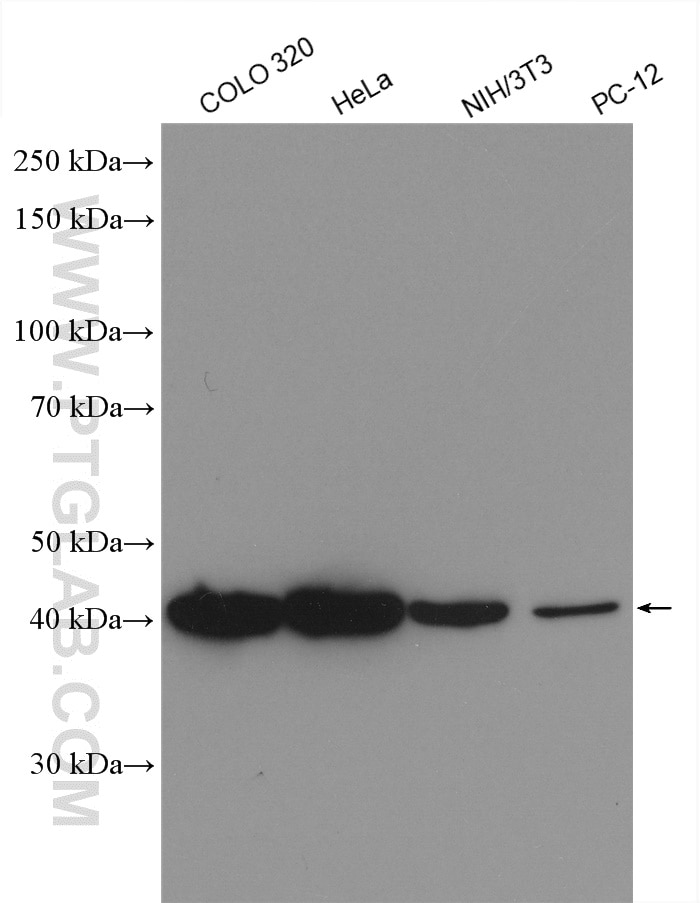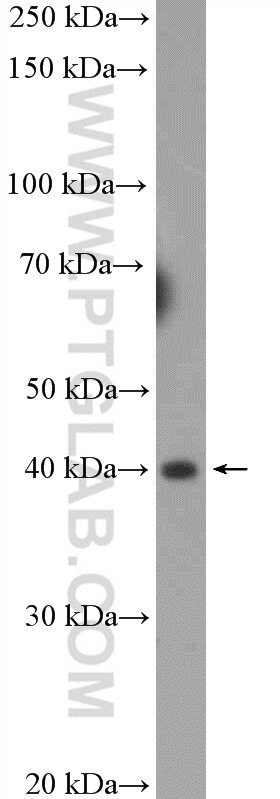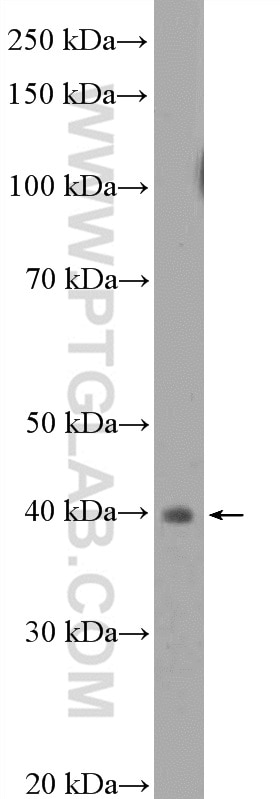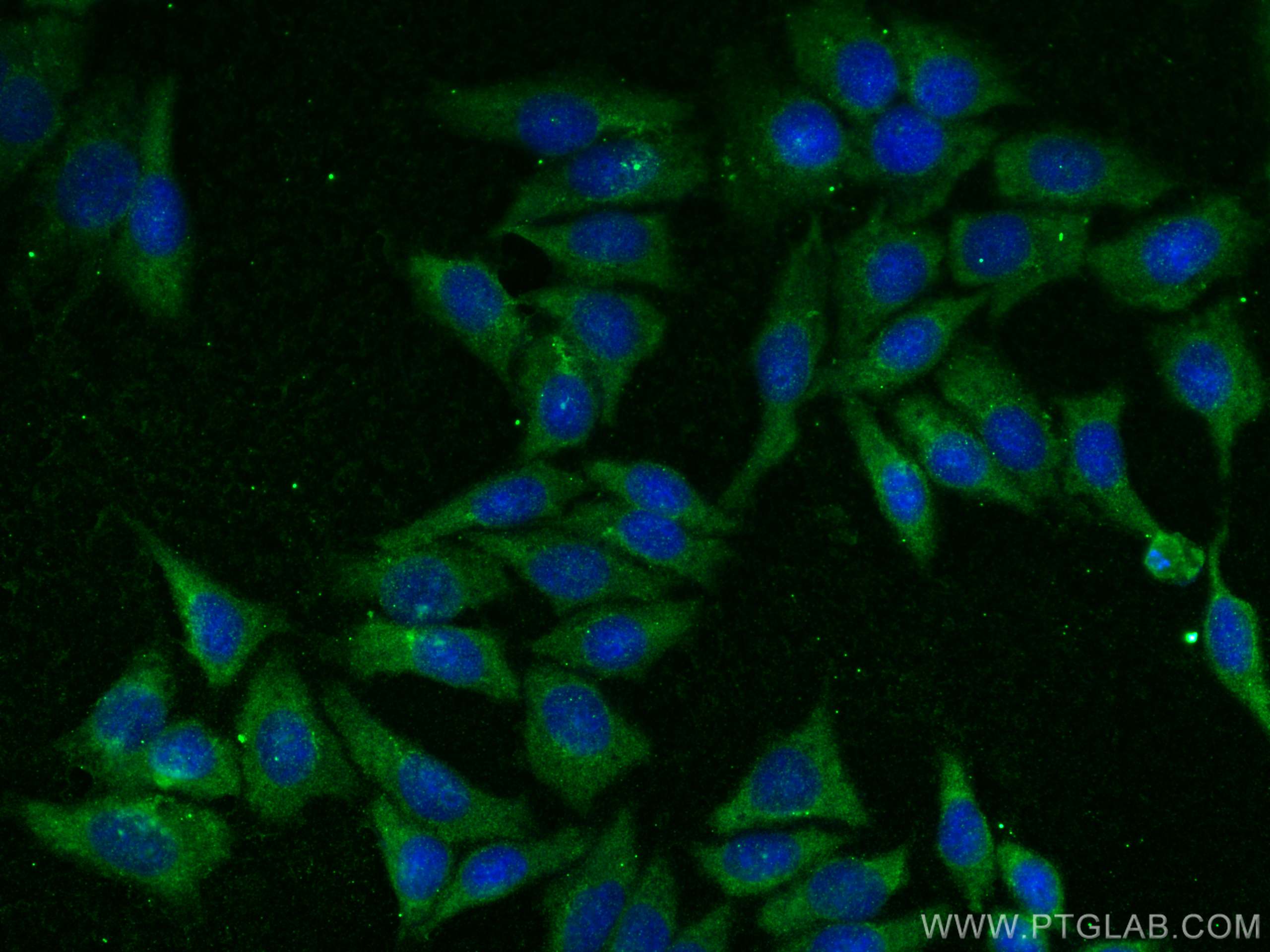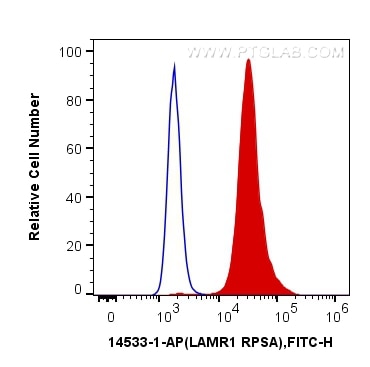- Featured Product
- KD/KO Validated
LAMR1,RPSA Polyclonal antibody
LAMR1,RPSA Polyclonal Antibody for WB, IF, FC, ELISA
Host / Isotype
Rabbit / IgG
Reactivity
human, mouse, rat and More (1)
Applications
WB, IF, FC, IHC, ELISA
Conjugate
Unconjugated
Cat no : 14533-1-AP
Synonyms
Validation Data Gallery
Tested Applications
| Positive WB detected in | COLO 320 cells, mouse liver tissue, mouse colon tissue, HeLa cells, NIH/3T3 cells, PC-12 cells |
| Positive IF detected in | HepG2 cells |
| Positive FC detected in | HeLa cells |
Recommended dilution
| Application | Dilution |
|---|---|
| Western Blot (WB) | WB : 1:1000-1:4000 |
| Immunofluorescence (IF) | IF : 1:200-1:800 |
| Flow Cytometry (FC) | FC : 0.20 ug per 10^6 cells in a 100 µl suspension |
| It is recommended that this reagent should be titrated in each testing system to obtain optimal results. | |
| Sample-dependent, Check data in validation data gallery. | |
Published Applications
| KD/KO | See 2 publications below |
| WB | See 10 publications below |
| IHC | See 2 publications below |
| IF | See 2 publications below |
Product Information
14533-1-AP targets LAMR1,RPSA in WB, IF, FC, IHC, ELISA applications and shows reactivity with human, mouse, rat samples.
| Tested Reactivity | human, mouse, rat |
| Cited Reactivity | human, mouse, pig |
| Host / Isotype | Rabbit / IgG |
| Class | Polyclonal |
| Type | Antibody |
| Immunogen | LAMR1,RPSA fusion protein Ag6033 |
| Full Name | ribosomal protein SA |
| Calculated Molecular Weight | 33 kDa |
| Observed Molecular Weight | 40 kDa |
| GenBank Accession Number | BC050688 |
| Gene Symbol | RPSA |
| Gene ID (NCBI) | 3921 |
| RRID | AB_2182528 |
| Conjugate | Unconjugated |
| Form | Liquid |
| Purification Method | Antigen affinity purification |
| Storage Buffer | PBS with 0.02% sodium azide and 50% glycerol pH 7.3. |
| Storage Conditions | Store at -20°C. Stable for one year after shipment. Aliquoting is unnecessary for -20oC storage. 20ul sizes contain 0.1% BSA. |
Background Information
The ribosomal protein SA (RPSA), previously named 67 kD laminin receptor(67LR), 37 kD laminin receptor precursor (37LRP) and p40 ribosome-associated protein, is a multifunctional protein, that plays a role in a number of pathological processes, such as cancer and prion diseases. It is overexpressed in various cancer cell lines, and the the level of the laminin receptor transcript is higher in colon carcinoma tissue and lung cancer cell line than their normal counterparts. This antibody is a rabbit polyclonal antibody raised against full length RPSA of human origin. This antibody is specific to RPSA (LAMR1).67LR derives from homo- or hetero- dimerization of a 37 kDa cytosolic precursor (37LRP)], most probably by fatty acid acylation. 37LRP is mostly found in the cytosol and nucleus [10] where it is involved in translational processes and maintenance of nuclear structures, respectively. 67LR is localized at the cell surface and it not only serves as a receptor for LM but also acts as a receptor for elastin, carbohydrates and the cellular prion protein.
Protocols
| Product Specific Protocols | |
|---|---|
| WB protocol for LAMR1,RPSA antibody 14533-1-AP | Download protocol |
| IF protocol for LAMR1,RPSA antibody 14533-1-AP | Download protocol |
| Standard Protocols | |
|---|---|
| Click here to view our Standard Protocols |
Publications
| Species | Application | Title |
|---|---|---|
Arterioscler Thromb Vasc Biol β1-Integrin Is Essential for Vasoregulation and Smooth Muscle Survival In Vivo. | ||
Virulence LAMR1 restricts Zika virus infection by attenuating the envelope protein ubiquitination.
| ||
Hum Gene Ther Strategies to Attenuate Myocardial Infarction and No-Reflow through Preservation of Vascular Integrity by Pigment Epithelium-derived Factor. | ||
Sci Rep Epigallocatechin-3-gallate inhibits H2O2-induced apoptosis in Mouse Vascular Smooth Muscle Cells via 67kD Laminin Receptor. | ||
Food Funct Theaflavin-3,3'-di-gallate represses prostate cancer by activating the PKCδ/aSMase signaling pathway through a 67 kDa laminin receptor. |
